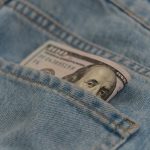Upholstery fabric costs vary based on the material you choose. Cotton typically runs $10 to $30 per yard, while linen is pricier at $20 to $60. Leather is the most expensive, ranging from $40 up to $200 depending on quality. Velvet can cost anywhere from $15 to $100, and synthetics like polyester are usually more affordable, around $10 to $30. Your fabric choice also influences durability and style. Keep exploring to find what fits your budget and needs best.
Table of Contents
Key Takeaways
- Cotton upholstery fabric ranges from $10 to $30 per yard, with premium weaves costing more.
- Linen fabric costs between $20 and $60 per yard, valued for breathability and strength.
- Leather upholstery varies widely from $40 to $200 per yard depending on quality and type.
- Velvet prices range from $15 to $100 per yard, influenced by fiber content and luxury level.
- Synthetic fabrics are typically $10 to $30 per yard, while wool ranges from $30 to $80 per yard.
Cost of Cotton Upholstery Fabric
When you choose cotton upholstery fabric, expect to pay between $10 and $30 per yard depending on quality and weave.
Cotton is popular because it’s soft, breathable, and durable, making it ideal for everyday furniture. If you go for basic weaves like plain or twill, you’ll pay closer to $10 to $15 per yard, which is budget-friendly.
However, premium weaves such as velvet or jacquard can push prices toward $25 or $30.
Cotton blends, often combined with synthetic fibers, can also affect the cost, sometimes offering better stain resistance and durability without a huge price jump.
Keep in mind, the fabric’s weight and finish also impact pricing, so heavier or specially treated cotton fabrics usually cost more.
Pricing for Linen Upholstery Material
Cotton offers affordability and comfort, but linen brings a different set of qualities that might catch your interest.
Linen is known for its durability and natural texture, making it a popular choice for upholstery with a sophisticated look. When it comes to pricing, linen upholstery fabric generally ranges from $20 to $60 per yard. The cost varies depending on the weave, brand, and whether it’s blended with other fibers.
Pure linen tends to be pricier due to its labor-intensive production. Keep in mind that linen’s breathability and strength can justify the higher upfront cost, especially if you want fabric that ages beautifully and lasts long.
If you’re aiming for a stylish, durable option, linen’s price point is worth considering.
Leather Upholstery Fabric Price Range
Although leather upholstery fabric tends to come at a higher price than many other materials, its durability and timeless appeal make it a popular investment.
Leather upholstery may cost more but offers lasting durability and classic style, making it a worthwhile investment.
You can expect to pay anywhere from $40 to $200 per yard, depending on the leather type, quality, and finish. Full-grain leather, the highest quality, usually costs between $150 and $200 per yard, while top-grain leather falls around $80 to $150.
Genuine leather, which is more affordable but less durable, typically ranges from $40 to $80 per yard. Keep in mind that exotic leather or specialty finishes can push prices even higher.
When choosing leather upholstery, consider how long you want it to last and the look you’re aiming for to balance cost with value.
Cost Considerations for Velvet Upholstery
When choosing velvet for your upholstery, you’ll find prices can vary widely depending on the type and quality.
Factors like fiber content, weave, and fabric origin play a big role in the cost. Understanding these elements helps you pick velvet that fits your style and budget.
Velvet Fabric Price Range
How much you’ll spend on velvet fabric largely depends on its quality, origin, and fiber content.
Generally, velvet fabric prices range from $15 to $100 per yard. Basic polyester velvet is the most affordable, usually costing between $15 and $30 per yard, making it a budget-friendly option for upholstery projects.
Mid-range velvets, often blends of cotton or viscose with synthetic fibers, typically fall between $30 and $60 per yard and offer a better feel and durability.
Luxury velvets made from pure silk or high-end cotton can cost $60 to $100 or more per yard, delivering exceptional softness and luster.
Knowing this range helps you choose velvet that fits your budget without sacrificing style or comfort.
Factors Affecting Velvet Cost
Understanding the price range of velvet fabric gives you a good starting point, but several factors can influence the final cost you’ll pay for upholstery velvet.
First, the fiber content matters—natural fibers like silk or cotton velvet tend to be pricier than synthetic blends.
The weave and pile height also affect cost; longer, denser piles require more material and labor. Additionally, the fabric’s origin and brand reputation can drive prices up.
If you want specialty finishes like stain resistance or extra durability, expect to pay more.
Finally, the quantity you need influences cost per yard, with larger orders often qualifying for discounts.
Keeping these factors in mind helps you choose velvet that fits both your style and budget without surprises.
Synthetic Upholstery Fabrics: Polyester and More
Many synthetic fabrics like polyester offer affordable, durable options for upholstery that fit a variety of styles and budgets.
When you choose polyester, you get a fabric that resists stains, fading, and wrinkles, making it great for high-traffic areas or homes with kids and pets.
Other synthetics like nylon, acrylic, and olefin also provide excellent durability and easy maintenance. Prices typically range from $10 to $30 per yard, depending on the blend and quality.
While synthetic fabrics may lack the natural feel of cotton or linen, their resilience and color retention make them a practical choice.
If you want upholstery that lasts without breaking the bank, synthetic fabrics like polyester are worth considering for your next project.
Wool Upholstery Fabric Costs
While synthetic fabrics like polyester offer durability and affordability, wool provides a different set of benefits worth considering for upholstery.
Wool is naturally resilient, flame-resistant, and excellent at regulating temperature, making it comfortable year-round.
When it comes to cost, wool upholstery fabric typically ranges from $30 to $80 per yard, depending on the wool type and weave. Higher-end options like merino or virgin wool push prices toward the upper end, while standard wool blends can be more budget-friendly.
Keep in mind, wool requires proper care to maintain its look and feel, but its durability often justifies the investment.
If you want upholstery that combines comfort, longevity, and natural fibers, wool is a solid choice despite its higher price compared to many synthetics.
Blended Fabric Options and Their Prices
Blended fabrics combine the best qualities of different fibers, offering a balance between durability, comfort, and cost.
When you choose blends like cotton-polyester or wool-nylon, you get fabrics that resist wrinkles, stains, and wear better than single fibers.
Prices for blended upholstery fabrics typically range from $15 to $40 per yard, depending on the fiber mix and weave quality.
For example, a cotton-polyester blend might cost around $15 to $25 per yard, making it an affordable, easy-care option.
More premium blends, such as wool-silk or wool-nylon, can run from $30 to $40 per yard, offering enhanced texture and durability.
Blended fabrics are a smart choice if you want the benefits of multiple fibers without breaking your budget.
Outdoor Upholstery Fabric Pricing
Since outdoor upholstery fabrics must withstand harsh weather and frequent use, they tend to cost more than indoor options. You’ll find that materials designed for outdoor furniture come with special treatments to resist UV rays, moisture, mildew, and fading. This durability contributes to a higher price point, but it’s worth it for long-lasting comfort and style outside.
| Fabric Type | Price per Yard |
|---|---|
| Solution-Dyed Acrylic | $25 – $45 |
| Olefin (Polypropylene) | $15 – $30 |
| Polyester with PVC coating | $20 – $40 |
| Textilene Mesh | $10 – $25 |
Choosing the right outdoor fabric means balancing cost with the level of protection you need for your space.
Factors Influencing Upholstery Fabric Costs
When choosing upholstery fabric, you’ll notice costs vary based on the type of fabric you select.
Patterns and weave complexity also play a big role in price differences.
Plus, durability and special finishes can add to the overall cost, so it’s important to take into account these factors carefully.
Fabric Type Impact
Although you mightn’t realize it at first, the type of fabric you choose plays a huge role in determining the overall cost of your upholstery. Different materials vary widely in price due to their availability, durability, and production process.
When selecting fabric, consider these key factors:
- Natural fibers like cotton and linen tend to be affordable but may wear faster.
- Leather is pricier but offers exceptional durability and a luxurious feel.
- Synthetic fabrics such as polyester often cost less and resist stains well.
- Specialty fabrics like velvet or silk usually carry a premium price due to their texture and finish.
- Eco-friendly or organic materials may cost more but appeal to sustainability-conscious buyers.
Your choice here directly affects both the upfront cost and how long your upholstery lasts.
Pattern and Weave Complexity
The complexity of a fabric’s pattern and weave considerably influences its cost, often more than you might expect.
When you choose intricate patterns like damask or brocade, expect to pay more since these require detailed craftsmanship and longer production times.
Similarly, complex weaves such as jacquard or double weave add layers of texture and depth, increasing the price due to the advanced machinery and skill involved.
On the other hand, simpler weaves like plain or twill tend to be more affordable because they’re quicker and easier to produce.
Keep in mind, if you want a unique design or multi-colored pattern, the cost will rise accordingly.
Fabric Durability and Finish
Patterns and weaves set the stage, but fabric durability and finish play a big role in determining how long your upholstery will last and how much it will cost.
When choosing fabric, you’ll want to take into account these key factors:
- Martindale or double rub rating: Higher ratings mean tougher fabric, usually at a higher price.
- Fiber content: Natural fibers like wool may cost more but offer durability; synthetics often resist stains better.
- Protective finishes: Treatments like stain-resistant or water-repellent coatings add to the price but extend fabric life.
- Texture and pile: Smooth fabrics often wear differently than napped or textured ones, affecting longevity.
- Maintenance needs: Easy-care fabrics can save money long-term, despite upfront costs.
Keep these in mind to balance durability, appearance, and budget effectively.
Frequently Asked Questions
How Do I Properly Clean Different Upholstery Fabrics?
You can’t just toss all upholstery fabrics in a washing machine like a wild party! You’ll want to spot clean velvet gently, vacuum woven fabrics often, and use mild soap on leather. Always test first!
What Are the Best Fabrics for Pet Owners?
You’ll want durable, tightly woven fabrics like microfiber, leather, or Crypton. They resist stains and scratches, making cleanup easier. Avoid delicate materials like silk or velvet, as pets can quickly damage them.
How Long Does Upholstery Fabric Typically Last?
Think of upholstery fabric as a loyal companion—it typically lasts 7 to 15 years, depending on use and care. If you choose durable materials and maintain them well, you’ll enjoy comfort for a long time.
Can Upholstery Fabric Be Recycled or Repurposed?
You can recycle or repurpose upholstery fabric by donating, crafting, or upcycling it into cushions or bags. Just check the material type, as some fabrics recycle more easily than others, making your effort eco-friendly.
What Upholstery Fabric Styles Are Trending This Year?
You’ll love the trending upholstery styles this year—bold geometrics, rich velvets, and sustainable linens are all the rage. Don’t forget earthy tones and textured weaves; they add warmth and personality to any space you’re updating.
- How to Choose Between Woven and Nonwoven Landscape Fabric - July 11, 2025
- What Are the Core Differences Between Woven and Nonwoven Geotextiles? - July 11, 2025
- A Comprehensive Look at the Nonwoven Fabric Industry - July 11, 2025






